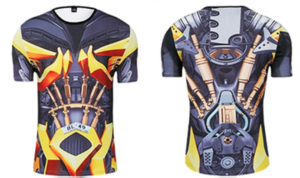Sublimation printing, also referred to as dye sublimation printing, is a printing method for transferring images onto a substrate (usually a cloth material such as polyester). Sublimation refers to a process where a substance moves from a solid to a gas state without ever being in a liquid state. Sublimation printing normally involves the use of a digital printer to produce mirrored images on paper that has been specially coated with a transfer material.
Heating Process
The transfer paper typically is placed into a heat press with the substrate and exposed to temperatures from 350 to 400 degrees Fahrenheit. This allows the ink and transfer material to move into the gas state. Once the ink and transfer material are in a gas state, they permeate the fibers of the substrate material.
Ink Transfer and Bonding
When the heat is removed from the transfer paper and substrate, the ink that has permeated the substrate fibers solidifies and is locked permanently into place by the transfer material. Assuming the procedure has been performed correctly, the image should never be subject to deterioration beyond that of the substrate itself.





